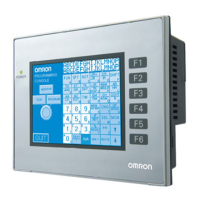xiii
Precautions for Safe Use
• When unpacking the Units and peripheral devices, check carefully for any external scratches or
other damage. Also, shake the products gently and check for any abnormal sound.
• Always install the Unit in the control panel.
• The mounting panel must be between 1.6 and 2.5 mm thick. Tighten the Mounting Brackets evenly
to a torque of 0.7 N·m to maintain water and dust resistance. Make sure the panel is not dirty or
warped and that it is strong enough to hold the Units.
• Do not let metal particles enter the Units when preparing the panel.
• Do not connect an AC power supply to the DC power terminals.
• Use reinforced insulation or double insulation for the DC power supply with minimal fluctuation volt-
age to the Unit. Ensure that a stable power output can be provided even if a 10-ms interruption
occurs at the input. Tighten the terminal block screws to a torque of 0.51 N·m.
Rated power supply voltage: 24 VDC (Allowable range: 21.6 to 27.6 VDC)
Capacity: 12 W minimum
• Do not perform a dielectric voltage test.
• Ground the Unit correctly to prevent malfunctions caused by noise.
• Do not touch the surface of the circuit board or the components mounted on it with your bare hands.
Discharge any static electricity from your body before handling the board.
• Confirm that the current capacity of the connected device is 250 mA or less before using 5VDC
power supply from the pin 6 of the serial port COM1 connectors. The 5VDC output of the Unit is
250 mA maximum at 5 V
±5%.
• Turn OFF the power supply before connecting or disconnecting cables.
• The tightening torque of the serial port COM1 is 0.6 N·m.
The tightening torque of the serial port COM2 is 0.2 N·m.
• The maximum tensile load for cables is 30 N. Do not apply loads greater than this.
• Confirm the safety of the system before turning ON or OFF the power supply.
• The whole system may stop depending on how the power supply is turned ON or OFF. Turn ON or
OFF the power supply according to the specified procedure.
• Start actual system application only after sufficiently checking screen data, macros, and the opera-
tion of the program in the host.
• To ensure the safety of the system, incorporate a program that can check that the Unit is properly
operating.
• Before initializing screen data, confirm that existing data is backed up at a computer.
• To use numeric input functions safely, always make maximum and minimum limit settings.
• An image will be burnt onto the screen if the same pattern is continuously displayed for a long period
of time (24 hours or longer as a guideline). To prevent screen burn, use a screen saver or switch dis-
plays periodically.
• Commercially available and recommended USB Hubs do not have the same specifications as the
NP-series PT. Normal operation may not be possible in environments subject to noise or static elec-
tricity. When using USB Hubs, be sure to provide sufficient measures to prevent noise and static
electricity, or install in a location that is not subject to noise or static electricity.
• Do not connect the USB connector to any device that is not applicable.
• Before connecting the USB connector to a device, make sure that the device is free of damage.
• Do not press the touch switch with a force greater than 30 N.
• Confirm the safety of the system before pressing touch switches.
• Signals from the touch switches may not be input if the switches are pressed consecutively at high
speed. Confirm each input before proceeding to the next one.

